Photos: Kip Miller
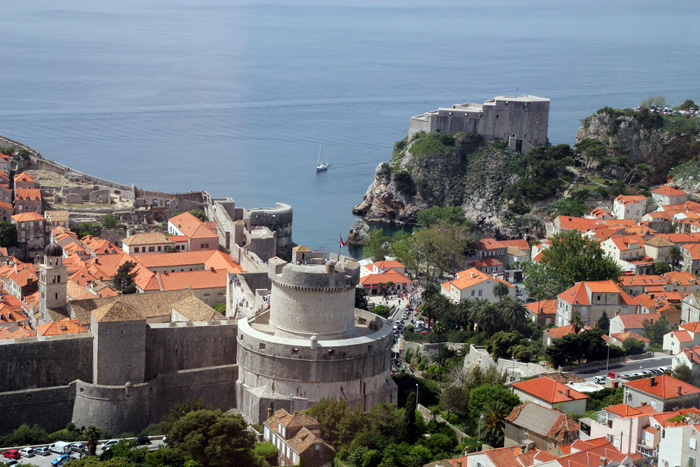
Dubrovnik's centuries-old, never-breached walls are crowned by Fort Minceta, its highest watchtower.
Lord Byron is said to have gone into raptures about Dubrovnik, calling it the "Pearl of the Adriatic." George Bernard Shaw claimed it was "Heaven on Earth!" Modern historians and archaeologists extol the former "Ragusa" for its remarkable state of preservation. This tiny republic, once under the protection of the Byzantines and briefly under the aegis of Venice, reigned as a powerful and independent state for centuries. Just as you would expect, it is a major destination for cruise ships that ply the limpid Adriatic in season, bringing hordes of tourists who disgorge at Dubrovnik's tiny harbor and overtake its streets for several hours each day. "Not to worry, we haven't hit high season yet," our tour director, Jelena, assures us. "I am fairly certain we will have the place pretty much to ourselves."
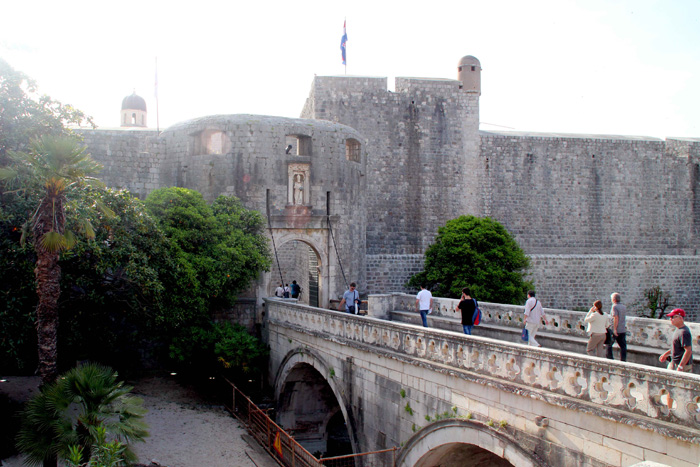
Everyman's vision of a medieval portal, Pyle Gate is the western entry point into Dubrovnik and part of its defensive walls.
As we check into the hotel, I am reminded that this property has a long and storied history. After its grand opening in 1897, a new era of upscale tourism was ushered in for the city. The Imperial quickly became known as a "hotel with a soul," attracting both privileged and ordinary travelers. Among its long list of guests were the Duke of Windsor and Wallis Simpson, plus assorted European glitterati who catapulted Dubrovnik onto the world tourism stage. During the recent Balkan War, the property suffered heavy shelling by Serbo-Montenegro forces which necessitated extensive repairs. The Imperial has never looked back. Today its prime location and high-end accommodations continue to draw worldwide guests. "Wow, we have so much to see and digest," I mumble, tossing and turning all night in anticipation. "How about if we sneak out for a peek at the Pyle Gate area before our morning tour?" I suggest to my husband. "Why not," he smiles. We are the first in line for the hotel's lavish buffet breakfast, heading out just after the morning mist has lifted. Pyle Gate is everyman's vision of a medieval gate. In centuries past it had an elaborate drawbridge that was pulled up each night. Today it is a stone passageway over what was once the moat, leading to Stradun, a wide street that heads straight toward the old port. "It seems as if the gate area is part of the walls that encircle the city," my husband observes. "We absolutely must walk the walls tomorrow. The views will be amazing!"
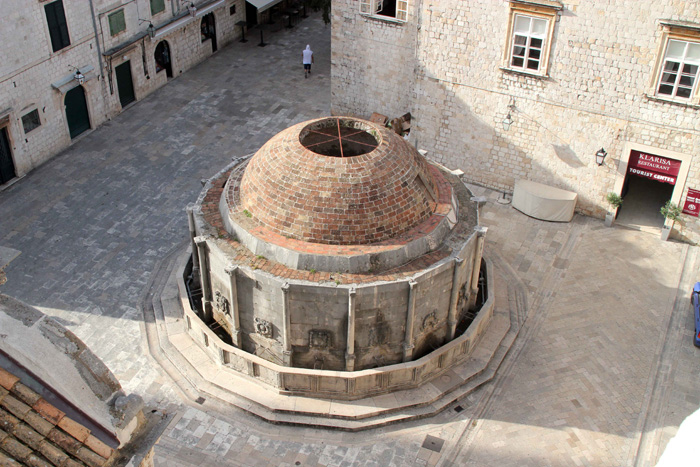
Onofrio's Fountain, a 16-sided structure dating from 1436, still supplies the city with fresh water from a nearby mountain stream.
"Dobro jutro (good morning)," exclaims Marko, our official local
guide, after an enthusiastic introduction by Jelena. "Are you ready
to discover a remarkable city, one that once ranked as the most advanced
maritime republic in the world? I am blessed to live within these walls
and I never cease to be amazed by this city," he brags. He directs
us to Onofrio's Fountain, only steps away. The massive 16-sided structure
dates back to 1436, designed by Onofrio Giordano della Cava, a prominent
Italian architect. It was part of an elaborate scheme to bring fresh water
to the Republic's citizens from the Dubrovacka River in the nearby mountains
via an aqueduct that poured directly into the fountain. "The quality
of the water is still outstanding today," Marko brags. "It even
surpasses bottled water and is perfect for refilling your empties. Please
take a close look at the 16 carved stone masks where the water streams
out. You will not find another fountain like it anywhere else the world!"
"Nearly
a million visitors from all over the world come to Dubrovnik each year,"
Marko continues. "Many celebrities have walked our streets, from
Michael Douglas and Catherine Zeta Jones to Beyoncé and Roger Moore,"
he begins to enumerate a long list. We follow him to the opposite side
of Stradun to the 14th century Franciscan Monastery which houses one of
world's oldest pharmacies. "The founders created this pharmacy to
take care of the medical needs of its friars," Marko explains. "It
is still operational and is open to the public. Take a few minutes to
get a close look at all the antique ceramics and old books." "For
sure this pharmacy is like no other!" my husband is impressed. "Aren't
the faïence jars magnificent?" We stop at the monastery's lower
cloister, an oasis of tranquility bordered by delicate Romanesque-Gothic,
columns depicting human, animal and plant life. I gaze at the columns
for several minutes and close my eyes, momentarily time-traveling to the
monastery's heyday.
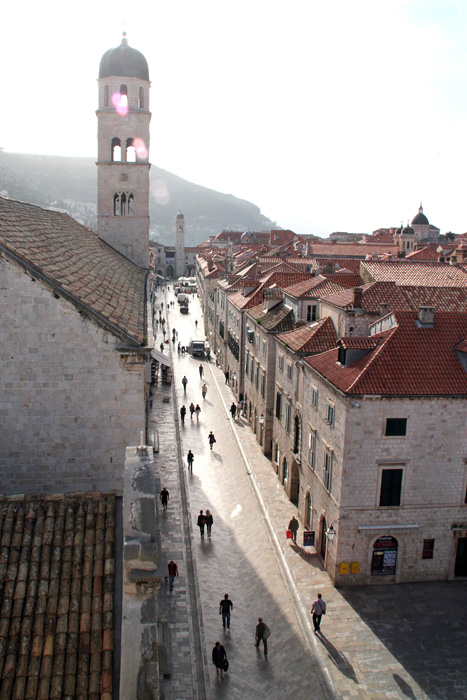
The Stradun, a wide avenue paved in polished limestone, links the western and eastern gates of the city.
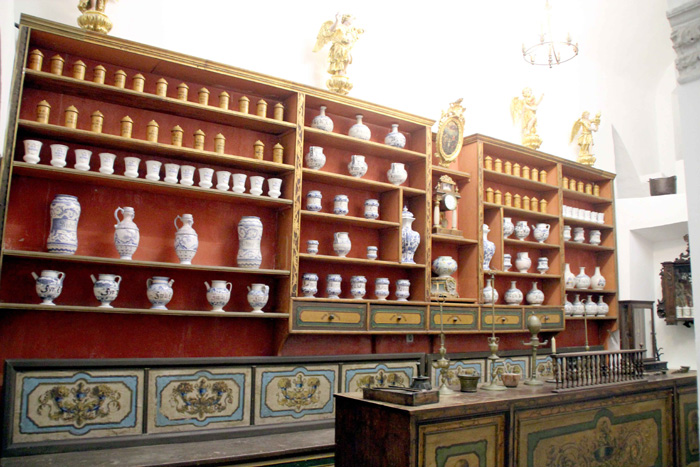
Dubrovnik's 14th century Franciscan Monastery is renowned for an old pharmacy with antique faïence jars.
The Stradun is a wide street paved in gleaming limestone polished by centuries of footsteps. The bottom floors of many of its Renaissance houses have been converted to souvenir shops, gelaterias and cafes filled during the busy season with customers culled from the non-stop river of humanity passing by. Church towers spike here and there: Franciscan, Dominican, Serbian Orthodox, Jesuit. "We are heading toward the port area where so much history was made," Marko raises his voice over the din of a competing tour group as we arrive at Luza Square, once the political and economic heart of old Ragusa. Towering overhead is a 15th century bell tower topped by tiny green figures that bang out the hours. On one end sits the church of St. Blaise, dedicated to the city's patron saint. "This massive baroque building dates from 1713 and it's built atop an earlier church that was destroyed in the 1667 earthquake," Marko explains. "From here an annual procession accompanied by street performances begins every year on February 3 in celebration of the saint's name day."
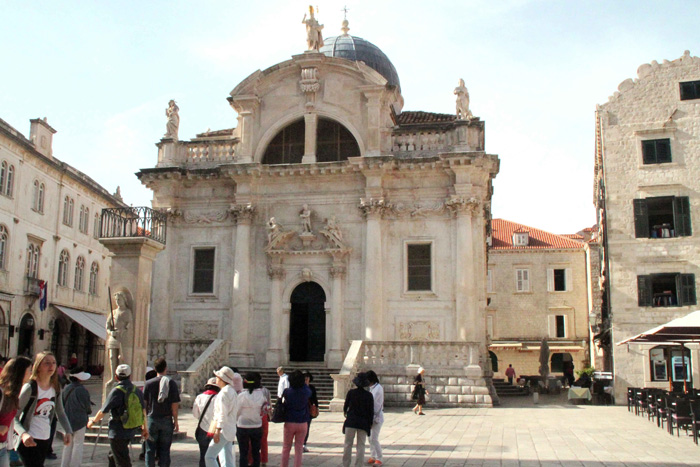
On the south side of Luza Square, the baroque Church of St. Blaise is dedicated to the city's patron saint.
Our group pauses in front of Orlando's Column, located under the city
bell tower. Dating back to 1418, it functions as a flagpole and a sculpture
that celebrates the city's hero-knight. "According to one urban legend,
Orlando saved Dubrovnik from a Saracen siege in the 9th century,"
Marko reveals. "But that turns out not to be true. Orlando is a multi-purpose
hero, and his forearm is used as a standard measure for the cubit."
I stop to admire the smaller version of Onofrio's Fountain nearby. Decorated
with dainty cherubic sculptures, it was created to supply water for the
bustling market that long ago commandeered this area. 'Wow, every inch
of the square is layered with history," says my husband. "Sponza
Palace is our next focus, Marko announces. "The name really means
'spongia,' a place where rainwater was collected. This building has served
numerous purposes through the years. Today it houses the city archives.
Every summer, we launch our annual festival here because it serves as
a good performance venue."
Rivaling Sponza is the nearby Rector's Palace. "It used to be the seat of the Rector of the Republic of Ragusa," Marko says. 'This Gothic-Renaissance masterpiece originally housed his office, several public halls and even a dungeon. The Rector had a one-month term and was not allowed to leave the premises during that time. Today it is a cultural museum filled with portraits and coats-of-arms and a variety of historic memorabilia." We stop to admire its striking façade lined with elegant columns crowned with ornate capitals. "There is a lot more to see in the immediate area, including the Ploce Gate which connects to the port area. But we are at the end of our tour," Marko smiles. "I hope you will take home many wonderful memories of your visit to Dubrovnik. Spend as much time as possible in this immediate area. You will be amazed by what you find!"
The two of
us continue toward Zadioska Street, a narrow lane off Stradun where Dubrovnik's
synagogue is still owned by the local Jewish community of 32 souls. The
city's Jewish history is rooted in the Spanish inquisition and the expulsion
that followed in 1492. In 1544 a ship of Portuguese refugees who had been
searching for a home arrived in Dubrovnik and were allowed to remain.
They became craftsmen and traders and formed the nucleus of a new community
which was allocated a street of its own. Over the centuries, the fortunes
of Dubrovnik's Jews waxed and waned, freed up under Napoleon, repressed
again when Dalmatia was annexed by Austria, until finally in the late
19th century new laws guaranteed them the equality they had been so desperately
yearning for. "When the Germans came to Croatia in World War II,
250 Jews living in Dubrovnik's ghetto were removed to the Rab concentration
camp," the synagogue attendant explains in amazingly good English.
"The tragic fate of nearly all of Europe's Jews," my husband
whispers as we admire the oversized ark shielding 13th century Iberian
Torahs behind a velvet curtain. "The synagogue has been redone several
times," the attendant adds. "In 1652 this space was converted
to Baroque style and the women's seating was moved to a new raised balcony
in the rear. Don't miss our beautiful 13th century Moorish carpet in the
exhibit. We believe it was a gift from Queen Isabella to her Jewish doctor
when he was forced to leave Spain." As we depart, I pause in front
of the gift shop display window. "OK, I am going in to buy their
book on "The Jews of Dubrovnik," I announce. "Please wait
for me."
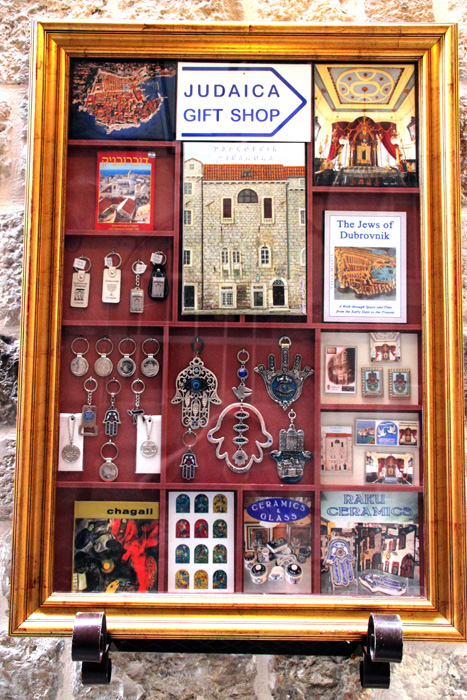
Zadioska Street houses a small synagogue still owned by the local Jewish
community.
Off a nearby stone staircase, Prijeko Street is lined with a string of alluring fish restaurants doing a brisk lunch business. "The food must be good here," my husband comments, "judging by how packed all the tables are." Just as we pass by a table with empty plates, a local couple gets up to offer us their seats. "We were about to leave," they smile, "Everything here is very good." I glance over at the next table laden with spectacular fish platters and several sides. "The food looks incredible. It's going to be hard to choose," I sigh as we scan the tri-lingual menu. Ultimately, we select a grilled sea bream entrée accompanied by two salads. I ask the waiter to bone it for us, something that is not customary in Dubrovnik. The lightly charred fish is moist and tangy. "Wow, it must have been plucked out of the sea this morning," my husband remarks as he skewers the last remaining morsel.
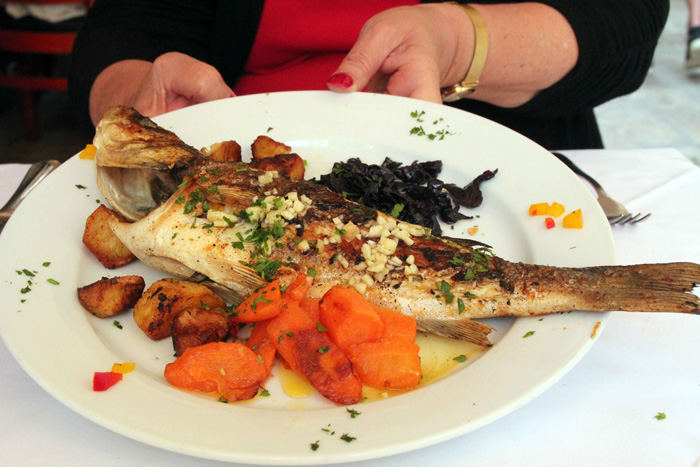
A narrow lane known as restaurant row is lined with alluring fish restaurants featuring fresh sea bream.
Dubrovnik's back streets reveal timeless snippets of local life. Overhead,
laundry is hung to dry under the brilliant sky. A trio of gossiping housewives
sit on adjoining door stoops trimming vegetables as mouthwatering aromas
waft out of their kitchen windows. A curly-haired boy is tugging at a
stubborn kite flapping in the sea breeze. Two chortling old men bent over
their chessboard reach for a half-empty bottle of Maraska Slivovitz. We
head north past Stradun to the city's main cathedral, a bulky baroque
building dating from 1672 whose first version was donated by Richard the
Lionhearted in gratitude for his safe landing on Lokrum Island after a
shipwreck. The big draw here is a painting of the "Assumption of
the Virgin," attributed to the Titian school and purchased for the
city by a wealthy brotherhood of merchants. Just beyond the cathedral,
Gunduliceva Poljana Square has finally concluded its daily produce market.
Tables, chairs and umbrellas are being removed, save for one vendor who
is offering free mojitos. "Why not, let's have a taste," we
agree. The mojito is a sublime blend of rum, sugar, lime juice, soda and
mint, and much more refreshing than a beer. "We'd be happy to come
back for dinner at your restaurant," we tell the attendant who is
passing out menus. "What is your specialty?" "Pizza and
pasta," he answers. "Perfect, see you later!" A discrete
sign points in the direction of Buza Bar, Durbrovnik's iconic watering
hole literally dug into the rocks facing the sea. Buza is always packed,
but if you can find an empty stool or rock, there is no better place to
relax. "This has got to be one of the best picture spots in the entire
city," my husband sighs as he scans the azure Adriatic and surrounding
islets.
"You have a free day today and the weather is perfect," Jelena announces after our breakfast spread on the hotel terrace. "And we have a very special treat lined up for this evening," she adds over her steaming espresso and cheese bourek. "We will all reconvene back at the hotel around four o'clock and then head out to a small farm on the outskirts of the city for an authentic culinary experience that you are absolutely going to love. In the meantime, I wish you a wonderful day. Be sure to take the cable car up to Mount Srd for a fantastic view of the city. And don't forget to visit the fortress that was built by Napoleon's army."
Precisely at nine a.m., we ascend the staircase near Pile Gate for our highly anticipated walk on the city walls. "OK, now I totally realize why 'Game of Thrones' is being filmed here in Dubrovnik," my husband remarks, overwhelmed by the sight of the entire city and breathtaking views in all directions. Dubrovnik's terra cotta rooftops range from deep orange and buff yellow to a rich chocolate brown, contrasting with the uniform gray of its limestone outer walls. Watchtowers and forts rise at various strategic points, providing extra security for the city whose thick walls have never been breached. Beyond, the limpid Adriatic glistens in the morning sun, with several islets looming in the distance. The Peljesac Peninsula, a long strip of fertile land renowned for its exceptional wineries and oyster beds, stretches to the northwest. Farther still lies Korcula, one of Croatia's most visited islands, shielded by coastal mountains that help protect it from the devastation of fierce Bura winds. "The Bura can blow sand way up in the sky and clog the air with haze," Jelena had told us. "It can rip trees from the soil, and create challenging sailing conditions that keep sailors at harbor. We always remain vigilant."
The city's
defensive walls take one's breath away. They were first built in the 10th
century and later reinforced by several talented architects who added
more watchtowers. Spanning some 940 meters, the walls reach a height of
25 meters in a few sections, with several areas reinforced by semicircular
bastions. But the dramatic highlight of a tour of the walls is its highest
point, Minceta Tower, up a steep staircase not far from Pile Gate. Begun
in 1319, it was completed in 1464 when it was surmounted by a second tower
with embrasures. "This is the most popular spot in all of Dubrovnik,"
a local man brags when he sees how impressed we are. "And it's also
one of the most important settings in 'Game of Thrones.'" Indeed,
the views here are beyond breathtaking, spanning the entire old town and
its suburbs, the waterfront area, Mount Srd overhead and several islands
shimmering in the distance.
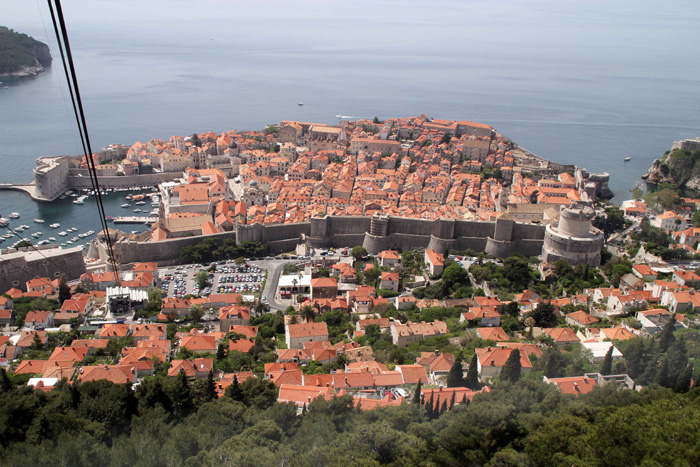
Our cable car ascent takes only three minutes, but the memory of the views lasts a lifetime.
We exit the walls at Buza Gate, the northern portal to the Old Town near the cable car entry point. Our ascent takes only three minutes, but the memory of the views will last a lifetime. The walled city below, now tightly compact, could be ripped from the pages of a Grimm's fairy tale. Beyond the harbor and outlying beaches lies Lokrum, a popular uninhabited island blanketed in palms, pines and cacti. We grab a view table on the edge of the Panorama Café terrace and order their shrimp pasta special. "OK, it's a bit overpriced, but we're paying for the view," I smile at my husband, thrilled to be at this very spot at this very moment. Behind us, the stony mountain is peppered with scrub and sage bushes that attract the local goat population. Just steps away from the cable car station is the entrance to the Dubrovnik Homeland War Museum," housed in the old Napoleonic fort. Throughout the 1991-1995 war, the fort was continuously bombarded and sustained serious damage, yet, miraculously, it was completely restored by 2012, just in time to celebrate the fort's 200th anniversary. Inside, photographs and artifacts showcase the war in graphic, lurid detail, including war crimes and atrocities. "I knew that this was a terrible war," I whisper to my husband, "but this is beyond what I could have imagined. This museum guarantees that Croatia's fierce battle for independence will never be forgotten."
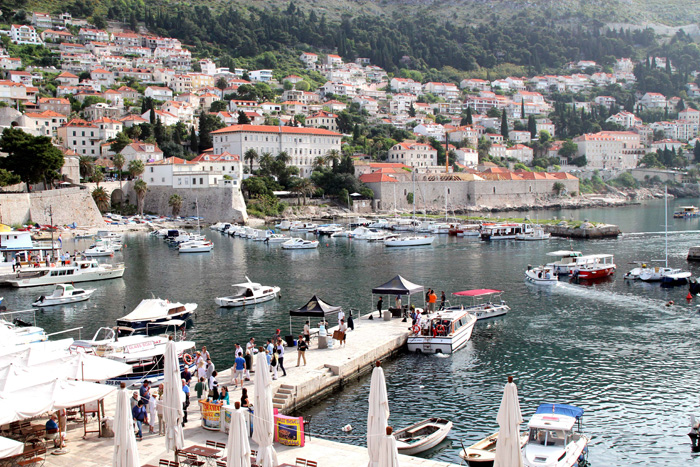
Dubrovnik's compact port area stretches behind Ploce Gate, connecting it to St. John's Fort.
"How about a nice, relaxing boat ride," my husband suggests as we exit the cable car. "A ride is just what I could use at this moment," I agree. Dubrovnik's port area stretches behind Ploce Gate, mirroring Pile Gate to the east and connecting to St. John's Fort. "No cruise ships in sight," I announce as I survey the small harbor with its protective breakwater and a variety of motor boats offering return excursions to nearby beaches and islands. We select one that offers a 60-minute foray around the walls. "Welcome aboard," says the friendly captain. "Where are you from?" "Los Angeles," we reply! "Californians, great. Please take a seat!" he commands. Our journey traces the massive outer walls that define the perimeter of the city. We head to the right, past the fortress of St. Ivan, slowly encircling the city, finally reaching the inner bays of Pile and Kolorina. Looming right in the middle is the infamous Lovrijenac Fortress crowning a dramatic 37-foot high promontory. "Construction on this pivotal fort began way back in the 11th century, "the captain explains. "Notice that it adheres to the shape of the rocks beneath. In its glory days it had ten cannons including a very famous one called 'lizard!' Because of its important protective role, this fort has become known as the Gibraltar of Dubrovnik," he adds. He shares several more stories, describing fort after fort as we circle back to the port. "At its peak, Dubrovnik had more than 130 cannons in its arsenal and a breakwater that was even larger than the current one," the captain explains as we pull in. "You've just had a quick taste of the city whose walls worked like a charm all these centuries. Please enjoy the rest of your time in Dubrovnik."
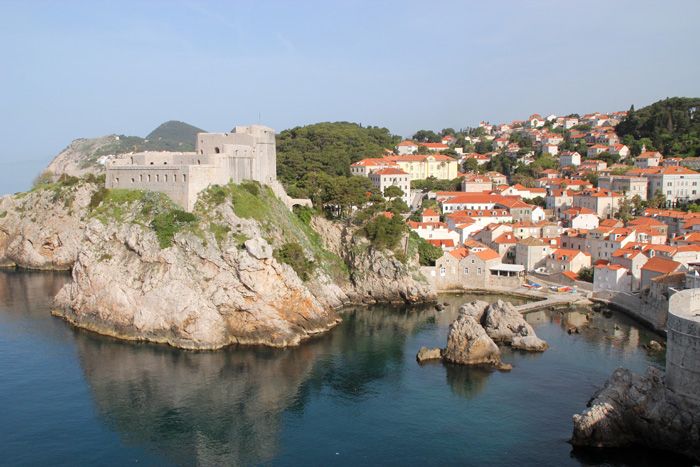
The infamous Lovrijenac Fortress crowns a dramatic 37-foot high promontory in the inner bay of Pile and Kolorina.
On the hotel terrace, our fellow tour mates are all sharing stories of their day's outings. "It's time. Let's go," Jelena interjects. We board a small bus that speeds to Dubrovnik's green countryside where a traditional farmhouse awaits. "Welcome, welcome," a charming, English-speaking couple shows us in. Long tables are set for dinner, back-dropped by rustic stone walls. "Please join me in the garden," the lady of the house insists. Several of us follow her to gather fresh herbs for dinner. "Now we would like to show you how we crush olives the old-fashioned way," our host declares. We head to the basement and gather around his centuries-old olive press powered by a horse that is tethered to the mechanism. "Amazing," I gasp as the horse goes round and round, moving heavy stones that crush the olives, extracting cold-pressed, extra-virgin oil. "Wow, I have been to several olive oil tastings, but this one is more flavorful than the best from Greece and Tuscany," I declare. "Now you must also taste our sage grappa," our host insists. Appetites whetted, we dive into their homemade prosciutto and an aromatic, crumbly sheep cheese from Pag Island, accompanied by juicy olives. With a big smile, he uncorks several bottles of local wine, made from Plavac Mali grapes, the pride of the Peljesac Peninsula. The wine is dense and robust, with notes of black cherry and spice, perfect for our rustic feast. Out comes a huge platter of marinated, char-grilled meats, with a side of crusty potatoes. For a grand finale, our hostess returns to the kitchen to bring out a huge rozata, the signature dessert of Dubrovnik. Similar to crème caramel, rozata is the beloved local custard traditionally flavored with drops of rose oil. "Oh wow, this is incredible!" one of our group declares. "We have to have this again during our remaining days in Croatia." "Hvala vam" (thank you). "Dovidenja" (good bye), we all exclaim in parting, having practiced these phrases repeatedly on the bus.
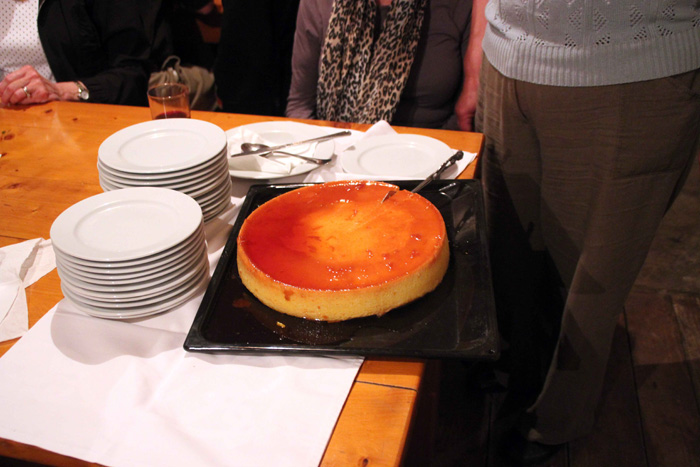
Our Dubrovnik farm dinner culminates with a delectable rozata, the signature local custard flavored with rose oil.
Dubrovnik is one incredible destination, I sigh as I slide under the covers,
elated. Sleep overtakes me just as I conjure up the next leg of our journey,
beginning with Croatia's most visited Dalmatian island - Hvar.
